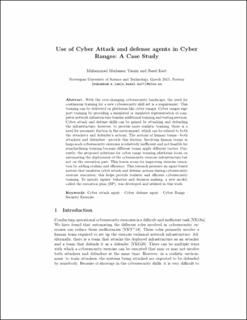| dc.contributor.author | Yamin, Muhammad Mudassar | |
| dc.contributor.author | Katt, Basel | |
| dc.date.accessioned | 2023-03-14T07:21:20Z | |
| dc.date.available | 2023-03-14T07:21:20Z | |
| dc.date.created | 2022-08-31T11:58:31Z | |
| dc.date.issued | 2022 | |
| dc.identifier.issn | 0167-4048 | |
| dc.identifier.uri | https://hdl.handle.net/11250/3058033 | |
| dc.description.abstract | With the ever-changing cybersecurity landscape, the need for a continuous training for new cybersecurity skill sets is a requirement. Such continuous training programs can be delivered on platforms like cyber ranges. Cyber ranges support training by providing a simulated or emulated representation of a computer network infrastructure, besides additional training and testing services. Cyber attack and defense skills can be gained by attacking and defending a simulated or an emulated infrastructure. However, to provide a realistic training in such infrastructures, there is a need for necessary friction in the environment. Human teams, playing both attackers’ and defenders’ roles, provide this friction. Involving human teams in large-scale cybersecurity exercises is relatively inefficient and not feasible for standardizing training because different teams apply different tactics. Currently, the proposed solutions for cyber range training platforms focus on automating the deployment of the cybersecurity exercise infrastructure but not on the execution part. This leaves a room for improving exercise execution by adding realism and efficiency. This research presents an agent-based system that emulates cyber attack and defense actions during cybersecurity exercise execution; this helps provide realistic and efficient cybersecurity training. To specify agents’ behavior and decision making, a new formal model, called the execution plan (EP), was developed and utilized in this work. | en_US |
| dc.language.iso | eng | en_US |
| dc.publisher | Elsevier | en_US |
| dc.rights | Attribution-NonCommercial-NoDerivatives 4.0 Internasjonal | * |
| dc.rights.uri | http://creativecommons.org/licenses/by-nc-nd/4.0/deed.no | * |
| dc.title | Use of cyber attack and defense agents in cyber ranges: A case study | en_US |
| dc.title.alternative | Use of cyber attack and defense agents in cyber ranges: A case study | en_US |
| dc.type | Peer reviewed | en_US |
| dc.type | Journal article | en_US |
| dc.description.version | acceptedVersion | en_US |
| dc.source.volume | 122 | en_US |
| dc.source.journal | Computers & Security | en_US |
| dc.identifier.doi | 10.1016/j.cose.2022.102892 | |
| dc.identifier.cristin | 2047540 | |
| cristin.ispublished | true | |
| cristin.fulltext | postprint | |
| cristin.qualitycode | 1 | |

